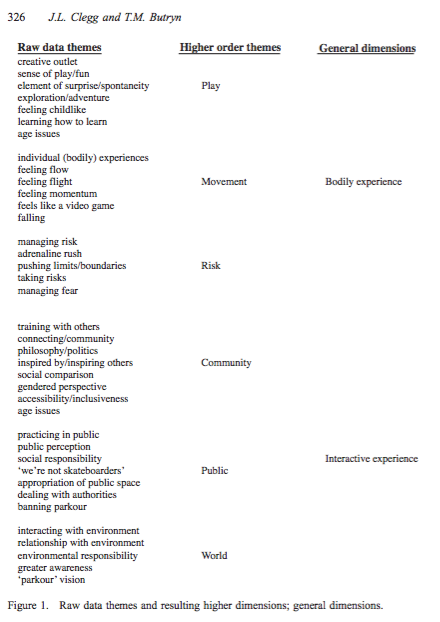This article is highly relevant to my choice of topic of outdoor recreational activity for young urban professionals, by providing me with keywords and boundaries to the define the scope of my project. This article is most relevant if my product is about creating a product which intentionally creates fun.
Free running is an emerging lifestyle sport which uses urban architecture as a means for purposive action. It is expressive and acrobatic. Although it is not the sport for everyone (most interpretations consists of a strong body and lots of energy), it fits the requirements that my project requires – for young urban professionals living in urban cities on a micro-adventure at any time, anywhere. Free running contributes to sport as a contested practice of cultural space, public life, and urban community.
Without formal rules and with many diverse styles, it allows a great freedom of interpretation. Adventurers choose their path, the movement, the speed and obstacles and decide on the techniques needed to negotiate obstacles. It is a means of way-finding.
Space can be reinterpreted in creative ways, which upsets power relations in urban settings. Quoting a participant of the survey:
Urban environments are designed for one of many uses, but the aim is to restrict, direct, and slow movement. I try to practice in areas that restrict and slow me as much as possible – it appeals to my sense of defiance against all those who designed the environment to restrict and control.
An urban space does not have to be physically modified, or drastically modified to allow new interpretations for adventure seekers. By working with the current urban landscape, new experiences can be created as well.
Perhaps at this point in time I am questioning myself about what I want to achieve from this project – a radical approach to designing an outdoor product to encourage fun, or an incremental approach, to enhance current experiences in urban outdoor activities by first picking out an activity which is could be re-interpreted to bring more joy than before.
For creating radical experiences and products to facilitate this, the article offers insights on what free runners look for in their sport, and the same ideas can be applied for most adventure seekers. It is a minimal requirement for sporting activities to provide a bodily experience and an interactive experience to be wholesome.

Participants described the sensations of doing parkour or freerunning from a subjective, first-person perspective. Three major themes emerged from participants’ descriptions of bodily sensations: play (general description), movement (specific description) and risk.
Article Abstract
The purpose of this investigation was to explore the embodied experiences of practitioners of parkour and freerunning. Phenomenological interviews were conducted with 11 (9 male and 2 female) intermediate-to-advanced traceurs (parkour practitioners) ranging from 18 to 33 years old. Specifically, Merleau-Ponty’s phenomenological approach, which focuses on bodily perspective, was used to uncover and describe the meaning of these experiences. Following lengthy in-depth phenomenological interviews, two dimensions emerged: bodily experience and interactive experience. Several supporting themes also emerged, including play, movement and risk within the bodily experience dimension, and community, public, and the world within the interactive experience dimension. The findings of this study provide new perspectives of the experiences and meanings associated with participating in parkour and freerunning, and both support and contradict previous academic work on parkour.
Article: an-existential-phenomenological-examination-of-parkour-and-freerunning
